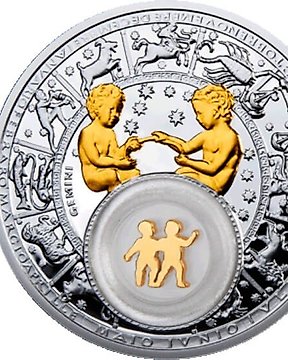
Hviterussland. 20 Roubles 2013 Gemini, Proof (Ingen reservasjonspris)
Nr. 81043429

Nr. 81043429

Name (ENG): The Belts of Slutsk. Nobleman’s Dress
Series: Coins of the Belts of Slutsk Series
Denomination (BYN): 20
Metal: Ag 925
Weight (gram): 33.62
Quality: PROOF
Diameter: 50.00
Issue Limit, pcs.: 7,000
Issue Date: 2013
Net one ounce silver coin. Includes original certificate of authenticity and information booklet.
The traditional noblemen society in the Polish-Lithuanian Commonwealth (Rzeczpospolita) was formed during the period which started in the late 16th century and ended in the second half of the 17th century. Although the local upper class was adopting the European mode, it tried to preserve the distinctive features of the national dress. The style of shirts, zupans (long garment), homespun coats, and other articles of clothing did not undergo material changes and was the same for different social classes. However, the fabrics used to make up clothes of magnates and nobility differed to a significant degree from the homemade cloths used by the ordinary people. Expensive velvet, silk, cloth, and fine-spun cotton were imported from the Orient.
A kuntusz – an article of outer garment, which was emulated from the Orient via Hungary and Poland, became the main element of the nobleman’s kuntusz or “sarmatian” dress. A kuntusz had slashed sleeves, was tailored to below the knees or short-cut and worn over zupan.
The obligatory accessories of the clothing ensemble, especially of the male one, were the leather, braided, and textile belts. In the 17th-18th centuries, it became fashionable to gird kuntusz with the soft Oriental, mostly Persian gold and silver woven belts. They became one of the main elements of the noblemen’s image. The stability of kuntusz mode in the widest noblemen circles led to the production of the famous belts of Sluts by the Radziwills’ manufactory.
In the midst of prosperous classes the national mode coexisted together with the European one. In the 18th century the influence of France in culture and policy expanded. In the expanses of Rzeczpospolita, where implementation of the democratic reforms commenced, the dress style demonstrated political views: the supporters of changes gave preference to the French fashion – tail coats, jabots, short pantaloons, while their conservative opponents wore traditional garment. This confrontation got the name “the war of a tail coat and a zupan”.
In 1793, when the next partition of Rzeczpospolita took place and the majority of the Belarusian lands fell to the Russian Empire, the persiarnya of Slutsk produced the “opposition” belts of green colour, making thereby a protest against the abolishment of Constitution passed on May 3, 1791. They were prohibited from wearing. In the territory of Belarus the dress of the “sarmatian” type was worn till the beginning of the 19th century.
The obverse has: the image of a fragment of the one-faced belt produced by the manufactory of Slutsk (1776-1780).
There is the marking “IOANNES/MADZARSKY” in the corner of one of the belt-ends. The other belt-end has the marking “MEFECIT/SLUCIAE”. Coloured silk, gold thread, gold fringe, weaving. The belt-end incorporates a three times repeat of the composition of the floral motive in the form of a stalk with two flowers on the main axis, four pair-wise symmetrical flowers, and six flower buds at the sides. The bottom of the motive is a pair-wise symmetrical dentate foliage.
The belt is exhibited in the National Museum of History and Culture of Belarus.
The "Coins of the Belts of Slutsk" series contains 5 different coins:
- Nobleman's Dress
- Weaving
- The Radziwills
- Markings
- Collecting
This coin was personally purchased by the seller at the National Bank of the Republic of Belarus in Minsk, Belarus. To prevent environmental contamination, the coin has never been taken out of its capsule. Any scratches or irregularities are solely on the surface of the capsule.
Hvordan kjøpe på Catawiki
1. Oppdag noe spesielt
2. Legg inn det høyeste budet
3. Å gjøre en sikker betaling